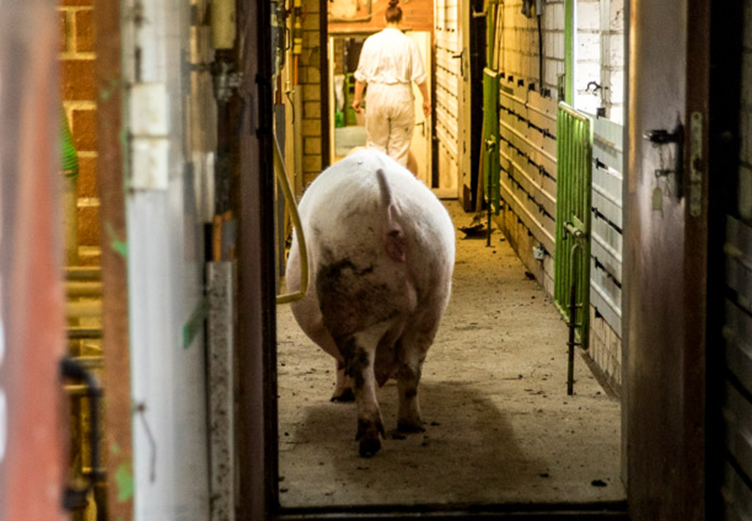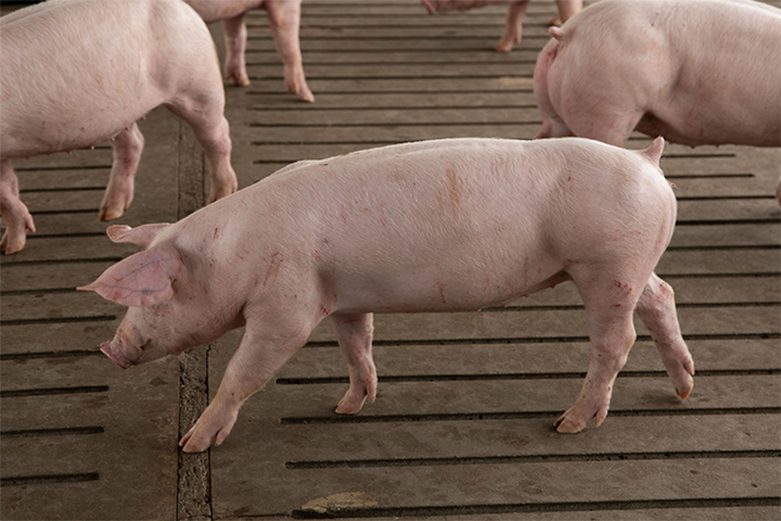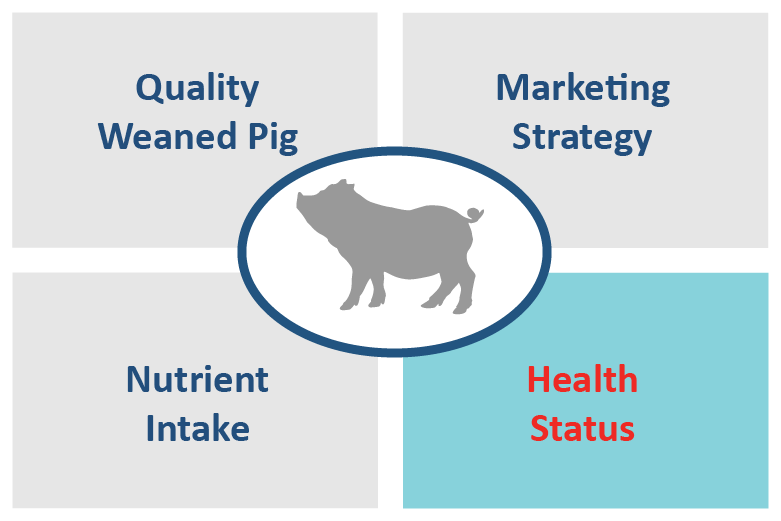Who doesn’t love walking into a farrowing room and seeing large, healthy litters of uniform pigs? Every pig is active and full, with clear eyes and no evidence of disease. Producers and veterinarians know these pigs have the best chance of becoming a quality weaned pig.
Every pig farrowed should have the opportunity to become a quality weaned pig, but producing pigs like this routinely doesn’t just happen. It takes good management on the part of caregivers. It takes pigs that are healthy, thrifty, the right age and weight, and consistent in their overall performance. If just one component is missing, it can negatively impact the others.
Good health is one of the most important factors a quality weaned pig must have, says Perry Harms, DVM, North American Health Assurance Director for PIC. Four areas impact the health of a quality weaned pig: genetics, management, herd health and nutrition.
Genetics
“Genetics form the basis of the pigs’ potential,” Dr. Harms says. “We focus on the lifetime of the pig when we make genetic decisions.”
Weaning weights are highly influenced by genetics.
“Weaning weight is a function of two things – the sow’s milking performance as well as the pig’s ability to nurse and stimulate the sow to produce more milk,” he says. “Anything that sets the foundation for both pig viability and vigor, as well as sow milking ability, can greatly improve weaning weights,” he says.
Sow robustness drives replacement rate and parity structure, impacting herd-health stability and how well the pig performs in its first month of life. Other factors influenced by genetics include pre-wean survivability, birth weights, number of teats and milking ability.
“These genetic traits are crucial to consistently producing a quality weaned pig,” Dr. Harms adds. “Genetics contribute to the health of a quality weaned pig through genetic gains that enhance the robustness of both the sow and the piglet.”
Management
Timing is crucial when it comes to the management of quality weaned pigs.
“It’s important to get pigs started right with the environment, temperature and management. You’re setting that intestine up and populating it with the microbes you want,” adds Darin Madsen, DVM, head of veterinary services for JBS.
Focus on two areas to support quality weaned pig potential: farrowing house management and day-one pig care.
“Farrowing house management starts before sows are placed and pigs are born,” Dr. Harms explains. Farrowing house management includes:
- Set-up: Design the farrowing room for sow and piglet success. Pay close attention to factors that impact the environment and the microenvironment. Set and monitor temperatures and minimize drafts to ensure piglets stay warm.
- Cleanliness: The room must be clean and dry when sows enter, with everything in working order. “We sanitize, disinfect and dry the building and room before we even bring animals into the barn,” Dr. Harms says.
- Water: Water intake impacts lactation. Check that nipples are working well and flow rates are correct.
Day 1 pig care is also a high priority.
“At a high level, Day 1 care is critical and should be part of farrowing room responsibilities – not just an afterthought,” Dr. Harms says. “The fundamentals include assisting both the sow and piglet when needed so piglets have the best chance of getting started in the first few minutes,” Dr. Harms says.
Within those first minutes, piglets should be dried, warmed up and have early access to the sow’s colostrum.
“These steps set piglets up nutritionally with a boost of energy and provide antibodies that are a critical part of protection against disease,” Dr. Harms explains.
Health
A healthy, quality weaned pig begins with a healthy, stable sow herd. When sow herd health is unstable, conception rates decrease, pre-wean mortality increases and both birth weight and the number of pigs born per litter are impacted.
“An unstable sow herd disrupts our daily activities on the farm because sows will continue to shed and circulate viruses to piglets. We find ourselves busy managing the problems and dealing with issues. It’s herd instability that creates problems for the whole farm,” Dr. Harms says.
Health is an important leg of the stool in producing a quality weaned pig, says Dr. Madsen. Endemic issues like porcine reproductive and respiratory syndrome (PRRS) can affect weaned pigs because they depress the pigs’ immune system.
“When PRRS is in an unstable state, it can wreak havoc on a pig’s immune system at a time when that pig is susceptible to everything else,” Dr. Madsen says. “Pig quality diminishes, and they just never take off.”
“We know pigs exposed to PRRS are compromised in the farrowing house and on out to the grow-finish phase,” Dr. Harms adds. “Those effects are lingering and are a major driver in pig quality, so any steps we can take to help stabilize those herds to major pathogens like PRRS are critical.”
Minimizing scours is another important component of producing a quality weaned pig, says Dr. Madsen. “If you’re in a PRRS-stable or negative state, enteric diseases typically will be the Achille’s heel that might not allow you to produce a weaned pig that can get started in the nursery stage of production.
“If we are doing our prevention and treatments well, we can minimize enteric issues upfront, and that’s a good predictor of a quality weaned pig,” he notes.
Influenza can minimize the production of quality weaned pigs, says Montserrat Torremorell, DVM, PhD, professor in veterinary population medicine at the University of Minnesota.
“Biosecurity practices and vaccination remain the primary means of preventing or minimizing transmission of influenza A virus in pigs,” she says.
A comprehensive biosecurity plan should:
- Restrict the entry of visitors.
- Prevent the entrance of people with flu-like symptoms.
- Implement shower-in/shower-out policies for all people entering the facilities.
- Include vaccination for farm personnel, vaccinated with seasonal flu vaccines.
- Implement strict sick-leave policies.
“Also, the use of personal protection equipment which includes face masks, eye protection and gloves should be encouraged,” Dr. Torremorell says.
Gilt acclimatization is another critical component of health for the sow herd and piglets.
“Prior to introducing replacement animals into farms, animals should be kept in isolation/quarantine facilities and tested before releasing them into the units,” Dr. Torremorell says.
Producers need to consider vaccinations and exposure timing as part of their herd-specific gilt acclimatization plan.
“Ensure compliance to protocols with appropriate vaccination, exposure and diagnostic procedures to understand disease presence and circulation before entering the sow farm,” Dr. Harms says. “Sows and gilts with good immunity pass along protection to their pigs, improving weaned pig quality.”
Farrowing house protocols can contain disease spread in a sow farm and within the farrowing room. Good biosecurity measures help ensure pathogens are not transmitted laterally.
“Process pigs efficiently and effectively to minimize infections,” Dr. Harms says. “Be timely and targeted in identifying and treating individual pigs. Do the needed diagnostic work-ups to make sure you’re taking the correct interventions and using tools appropriately.”
Cross-fostering is a common management tool in operations, but it leads to difficult decisions, Dr. Harms says.
“It is often the first farrowing-house protocol stopped or removed when a disease outbreak occurs because the process can lead to disease spread,” he says. “Excessive cross-fostering can cause problems, not only in the farrowing house but in how we set up those pigs for subsequent performance.
“We have to keep a balance in mind, however,” Dr. Harms adds. “There are individual pigs and individual litters that benefit from cross-fostering.”
Fitting it all together
Producing a quality weaned pig means focusing on details and putting all the pieces together.
“I truly believe it’s multi-factorial,” Dr. Madsen says. “These things are intertwined. It’s having everybody in sync and understanding where we need to go as a team to do what is best for the animal. That will result in a healthy sow herd and more healthy quality weaned pigs.”
To learn more, contact your PIC team!
Article by JoAnn Alumbaugh and originally featured in Farm Journal’s Pork, USA.




